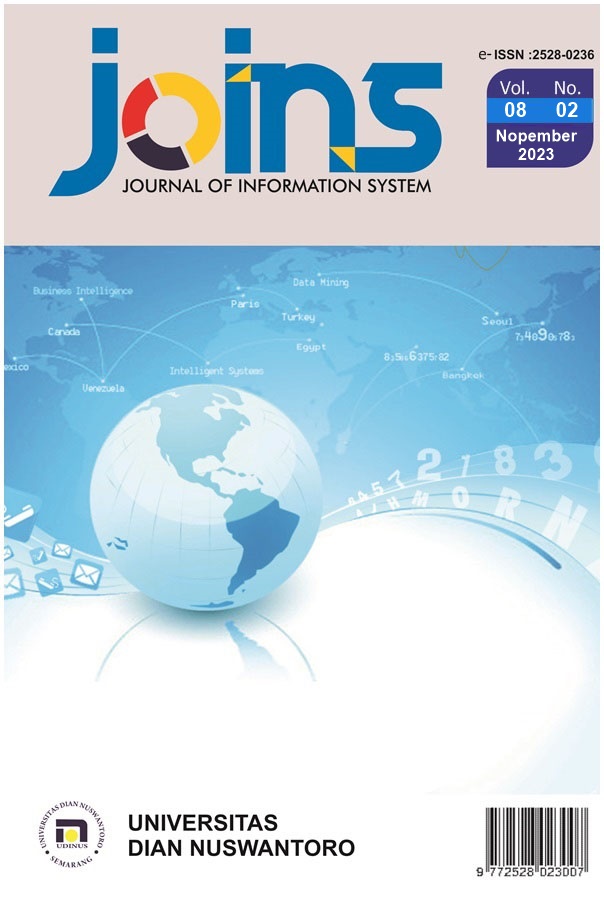A Web-based Point of Sales for Automotive Component Industry using Rapid Application Development model
DOI:
https://doi.org/10.33633/joins.v8i2.9383Keywords:
Automotive Component, Point of Sale, Rapid Application Development, System Usability Scale, Web-basedAbstract
This research aims to increase efficiency in Micro, Small, and Medium Enterprises (MSMEs) in the automotive components industry, focusing on CV Bengkel Megamakmur. This workshop is one of the MSMEs engaged in Indonesia's car spare parts industry. In the ongoing business process, these MSMEs need some help in inventory management, stock of goods, and less integrated sales transaction recording. The main problem identified was the discrepancy between the number of products sold and sales transaction reports. A web-based Point of Sale (POS) application was implemented, which allows the integration of inventory data and sales transactions. The method used in this research is Rapid Application Development (RAD), suitable for projects with limited resources and short work schedules. This research results in a Point of Sale application that can optimize business processes for managing inventory by monitoring stock and recording sales transactions in an integrated manner. This application has been tested using the System Usability Scale (SUS) method and obtained an average score of 86.6, included in the "very good" category. The test results show that this application has good functionality and can optimize MSME business processes in the automotive components industry.References
M. Danuri, “Development and transformation of digital technology,” Infokam, vol. XV, no. II, pp. 116–123, 2019.
O. P. Mares, G. B. Mahardika, and M. A. R. Wijaya, “Alternative solution for human error in hospitality industry,” J. Gastro Tour., vol. 1, no. 1, pp. 28–34, 2023, doi: 10.52465/jogasto.v1i1.126.
A. Susanto, “Pelatihan dan Pendampingan Usaha Kecil Mikro Bengkel Mobil di Kabupaten Purworejo untuk Meningkatkan Daya Saing dan Pelayanan,” Surya Abdimas, vol. 4, no. 2, pp. 44–52, 2020, doi: 10.37729/abdimas.v4i2.575.
M. Y. Nasrulloh and Y. H. Putra, “The Role of Information Technology in Handicraft and Entrepreneurship Subjects on the Students’ Entrepreneurial Interest,” Proc. Int. Conf. Business, Econ. Soc. Sci. Humanit. – Econ. Bus. Manag. Track (ICOBEST-EBM 2019), vol. 112, pp. 6–8, 2020, doi: 10.2991/aebmr.k.200108.003.
S. Aziza and G. H. N. N. Rahayu, “Implementasi Sistem Enterprise Resource Planning Berbasis Odoo Modul Sales Dengan Metode Rad Pada Pt Xyz,” J. Ind. Serv., vol. 5, no. 1, pp. 49–58, 2019, doi: 10.36055/jiss.v5i1.6503.
J. Alexander and N. Husufa, “Implementasi point of sales berbasis web pada usaha Olive Cafe,” Juli, vol. 2, pp. 1–14, 2020, [Online]. Available: https://jurnal.ikhafi.or.id/index.php/jusibi/452
S. Suryasari, T. J. Wibowo, A. Aribowo, and A. E. Widjaja, “Sistem Informasi Penunjang Proses Pemesanan dan Desain Kue Pada Toko Kue Artisan Online Berbasis Web,” Ultim. InfoSys J. Ilmu Sist. Inf., vol. 10, no. 1, pp. 48–54, 2019, doi: 10.31937/si.v10i1.1048.
A. Smaradhana Dwiekisatria and T. Nurhastuti, “Implementasi Sistem Informasi Point Of Sale Pada PT Maggot Indonesia Lestari Berbasis Web,” J. Teknol. Inf., vol. 7, no. 2, pp. 161–169, 2021, doi: 10.52643/jti.v7i2.1909.
J. Wiratama and R. Ikana Desanti, “The Development of Web-based Sales Reporting Information Systems using Rapid Application Development Method,” Ultim. Infosys J. Ilmu Sist. Inf., vol. 13, no. 2, pp. 110–116, 2022.
L. Listiani and F. Natalia, “Rancang Bangun Aplikasi Manpower Request Bagian Recruitment pada PT Dynapack Asia,” Ultim. InfoSys J. Ilmu Sist. Inf., vol. 10, no. 1, pp. 55–60, 2019, doi: 10.31937/si.v10i1.866.
A. S. S. A. W. Johan G. Ony, “Implementation of Business Strategy, Technology Usage, and Business Continuity during the Covid-19 Pandemic,” J. Akunt., vol. 25, no. 2, p. 186, 2021, doi: 10.24912/ja.v25i2.805.
G. B. Mangmang, “Development and Implementation of Point of Sale System (POS): Pro?tability Measurement for Retail Business,” 2018. [Online]. Available: https://api.semanticscholar.org/CorpusID:86556360
B. Rizki, N. G. Ginasta, M. A. Tamrin, and A. Rahman, “Customer Loyality Segmentation on Point of Sale System Using Recency-Frequency-Monetary (RFM) and K-Means,” J. Online Inform., vol. 5, no. 2, p. 130, 2020, doi: 10.15575/join.v5i2.511.
S. B. A. S. U. Rani, “A detailed study of Software Development Life Cycle (SDLC) Models,” Int. J. Eng. Comput. Sci., vol. 6, 2017, [Online]. Available: https://api.semanticscholar.org/CorpusID:67720820
D. Dennis, Alan; Wixom, Barbara; David; Tegarden, Systems Analysis and Design: An Object-Oriented Approach with UML, Sixth. United States: Wiley, 2020. [Online]. Available: https://umnlibrary.vitalsource.com/books/9781119561217
S. Nabila, A. R. Putri, A. Hafizhah, F. H. Rahmah, and R. Muslikhah, “Pemodelan Diagram UML Pada Perancangan Sistem Aplikasi Konsultasi Hewan Peliharaan Berbasis Android (Studi Kasus: Alopet),” J. Ilmu Komput. dan Bisnis, vol. 12, no. 2, pp. 130–139, 2021, doi: 10.47927/jikb.v12i2.150.
P. Sha, S. Chen, L. Zheng, X. Liu, H. Tang, and Y. Li, “Design and Implement of Microservice System for Edge Computing,” IFAC-PapersOnLine, vol. 53, no. 5, pp. 507–511, 2020, doi: 10.1016/j.ifacol.2021.04.137.
A. A. J. Permana, I. G. P. Sindu, and I. M. Pageh, “Developing home health care application for patient during the covid-19 pandemic,” J. Phys. Conf. Ser., vol. 1810, no. 1, 2021, doi: 10.1088/1742-6596/1810/1/012009.
A. Bangor, P. T. Kortum, and J. T. Miller, “An Empirical Evaluation of the System Usability Scale,” Int. J. Human–Computer Interact., vol. 24, no. 6, pp. 574–594, Jul. 2008, doi: 10.1080/10447310802205776.
A. El Murabet and A. Abtoy, “Methodologies of the Validation of Software Architectures,” 2023.
Downloads
Published
How to Cite
Issue
Section
License
Authors who publish with this journal agree to the following terms:
- Authors retain copyright and grant the journal right of first publication with the work simultaneously licensed under a Creative Commons Attribution License that allows others to share the work with an acknowledgement of the work's authorship and initial publication in this journal.
- Authors are able to enter into separate, additional contractual arrangements for the non-exclusive distribution of the journal's published version of the work (e.g., post it to an institutional repository or publish it in a book), with an acknowledgement of its initial publication in this journal.
- Authors are permitted and encouraged to post their work online (e.g., in institutional repositories or on their website) prior to and during the submission process, as it can lead to productive exchanges, as well as earlier and greater citation of published work (See The Effect of Open Access).

This work is licensed under a Creative Commons Attribution 4.0 International License.






















